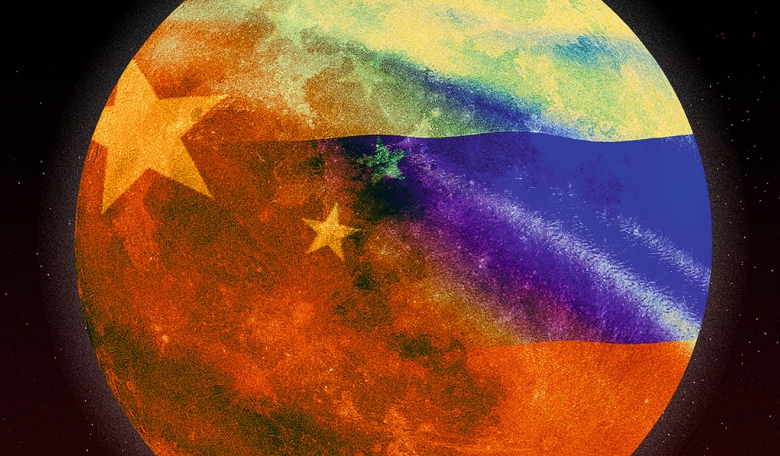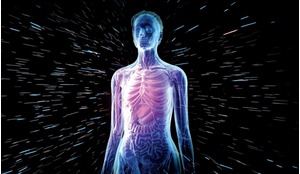Dramatic headlines regaled the space community this spring, some published by newspapers that ought to know better. “Russia and China building Moon base!” they shouted, and “Russia quits International Space Station!” The truth, as usual, is more mundane, but no less interesting. Here we assess the state of play between Russia and China, their lunar and other intentions, cooperation projects in train; and whether this really is the division of the space world into a bipolar domain with Russia and China on one side and the United States, Europe and the rest on the other.
To use police vernacular, Russian-Chinese relationships in the space field have ‘form’. They had a bright start in the 1950s when the Soviet Union supplied China with its early rocket designs, but the Chinese always suspected - rightly it seems - that they were sent quite obsolete blueprints. The relationship ended in tears with the great split of 1960, but left an architectural legacy in the form of the design and layout of the early Jiuquan cosmodrome.
The two sides had no contact until China went shopping in Moscow in the ‘new Russia’ in 1992, buying docking systems, spacesuits and training time in Star Town for two prospective cosmonauts (or ‘hangtianyuan’ in Chinese). There were several items the Russians would not sell, notably their best-in-the-world rocket engines, although the Chinese separately bought lunar module rocket engines from the Yangel design bureau in Ukraine. They also set up working groups on a range of space activities, including space stations, lunar and interplanetary missions, supplemented by polite meetings at senior level. The function of the groups, which continue to meet, is information exchange: the Chinese are likely to have learned much about how to build space stations (1971 onwards); return samples from the Moon (1970-6); and landing on Mars, where the USSR was first to achieve a soft-landing in 1971.
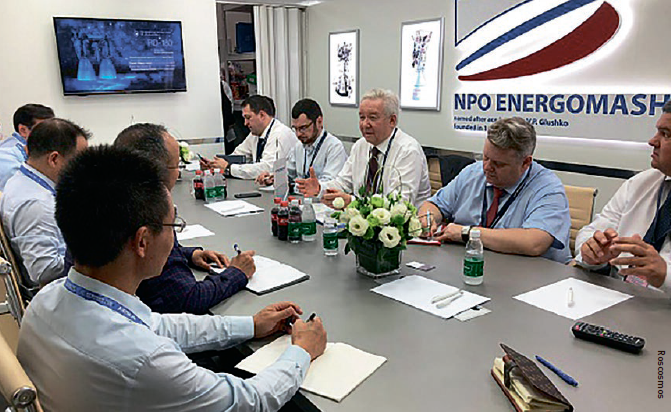 Chinese and Russian representatives meet at Russia’s rocket engine design bureau, Energomash.
Chinese and Russian representatives meet at Russia’s rocket engine design bureau, Energomash.
Lunar axis
Russia and China could still be described, at this stage, as flirting with the other, both somewhat nervously
This relationship was relatively static until the announcement in March 2021 of an agreement to build a lunar base. This was most likely prompted by the planned American return to the Moon, the Gateway project and then the Artemis Accords. Unlike the International Space Station (ISS), which was designed and operated by a partnership of the United States, Russia, Europe, Japan and Canada, the United States made it plain from the start that this was an American design and operation. Other countries could offer components, which might or might not be accepted (Europe builds the Orion service module, for example), but it would be NASA-supervised and directed throughout. Having been a co-equal on the ISS, such subordination was not acceptable to a self-respecting space power like Russia, especially the first-ever space-faring nation.
Russia never made a secret of its ultimate desire to reach and land on the Moon. Its new piloted spaceship, Orel, was designed from the start with this purpose in mind, along with the new heavy-lift launcher, the Soyuz 5, with a target date of a lunar landing in 2030. Indeed, under the Sirius programme, simulated lunar missions in Orel have already taken place.
 This artwork for a design concept for the proposed International Lunar Research Station (ILRS) by Guo Linli includes Russia’s Luna 27 lander.
This artwork for a design concept for the proposed International Lunar Research Station (ILRS) by Guo Linli includes Russia’s Luna 27 lander.
The ambitious Roscosmos director, Dmitry Rogozin, followed in the footsteps of the 1970s chief designer, Valentin Glushko, who took the view that the best response to Apollo was not to match it, but to exceed it with a proper lunar base with crews spending months there, like Antarctica. Several lunar bases were imagined in the Soviet period, the most famous by Vladimir Barmin’s design bureau, ‘Galaktika’; another, ‘Zvezda’ by Ivan Prudnikov. The only concrete outcome was that a version was turned into a nice children’s plastic toy sold in the Detsky Mir store.
The Chinese, ever thinking long term, first set down a lunar base as an aspiration in the famous 2009 Roadmap to 2050. This prompted a Chinese lunar base design, presented by Prof Guo Linli in 2013, though nobody took much notice at the time. Her design was on much the same lines as Galaktika and Zvezda, but used modern construction techniques like 3D printing and took advantage of China’s experiments in closed life support systems developed by Moscow-educated Liu Hong in the Yuegong ‘lunar palaces’. China too, declared its interest to reach the Moon by 2030 with the new CZ-9 heavy lifter, for which development of the engines is already well under way.
In the meantime, Russia and China signed up to ‘cooperate’ on the unmanned lunar programme to precede the Moon base. More by accident than design, Russia and China found themselves at a similar point in the development of their unmanned lunar programme (see table). China achieved its first lunar landing in 2013, a far side landing in 2019 and a sample return in 2020 (Chang’e 3-5), but had three more lunar spacecraft in preparation (Chang’e 6-8).
Russia, by contrast, wanted to resume its automated programme where it had left off in 1976 and also had several spacecraft in preparation, Luna 25-28, with similar timelines. Both liked the idea of an automated base to precede an occupied base in the same location, first sketched by the Russians under the title of ‘Luna Polygon’. Thus, two parallel programmes are now in preparation, with all landers being targeted at the south pole, the favoured Moon base location.
Such ‘cooperation’ originally meant the sharing of plans and fast-tracking subsequent scientific results: a common data centre, with two hubs, was agreed. It is more than that now, for the latest illustration shows that the two countries will share the same south polar site. Alexander Basilevsky, who identified the sites for earlier Luna landings and the proposed landing by cosmonauts, returned to identify sites for the new landings, such as crater Boguslavsky.
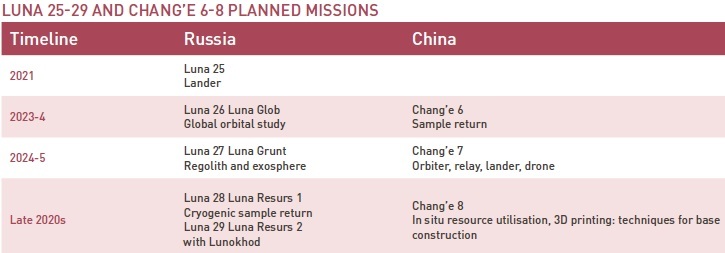 LUNA 25-29 AND CHANG’E 6-8 PLANNED MISSIONS
LUNA 25-29 AND CHANG’E 6-8 PLANNED MISSIONS
Space station axis
The Chinese, ever thinking long term, first set down a lunar base as an aspiration in the famous 2009 Roadmap to 2050
Russia flew the first space station (Salyut, 1971) and has more space station experience than any other country, keeping the ISS going when the shuttle was grounded. It is likely that Russia shared this experience with China, but we should avoid the conclusion that China ‘copied’ Russian designs. More likely, they learned from their experiences: China put huge effort into perfecting docking techniques on the Shenzhou missions to the Tiangong-1 and -2 laboratories, with repeated re-dockings, to avoid the problems that the USSR encountered in the 1970s.
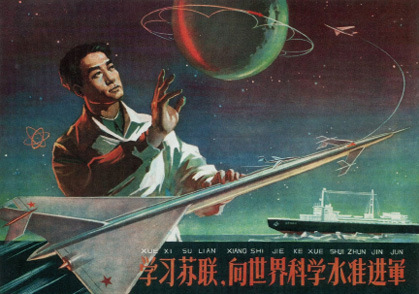 ‘Sino Soviet cooperation in the 1950s’, promoting the ‘Great Leap Forward’ (1956-1960).
‘Sino Soviet cooperation in the 1950s’, promoting the ‘Great Leap Forward’ (1956-1960).
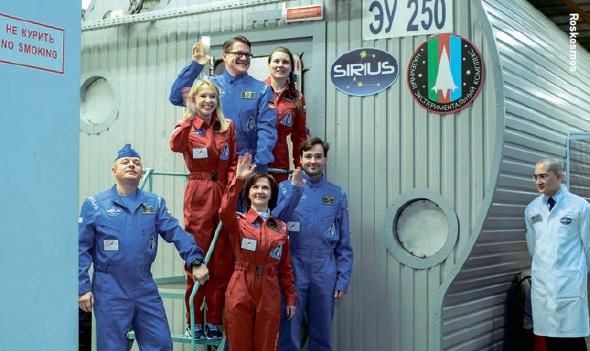 SIRIUS crew emerges from lunar flight simulation.
SIRIUS crew emerges from lunar flight simulation.
The decision of Russia and China to develop a joint lunar base prompted speculation that the two countries would also consider joint space station operations. By the start of the 2020s, the International Space Station was ageing, most evident in persistent minor leaks in the Zvezda module. Reports that Russia was considering its own space station fuelled rumours that Russia would leave the ISS in bad temper and operate a space station with China. Shortly before China launched its first space station, Tianhe in April 2021, there were reports that Russia asked China to put Tianhe into a higher-inclined orbit flying over Russia to make joint operations possible. This fanciful but impractical proposal is unlikely to have happened, granted that orbital tracking systems for Tianhe’s planned path had been set up years beforehand.
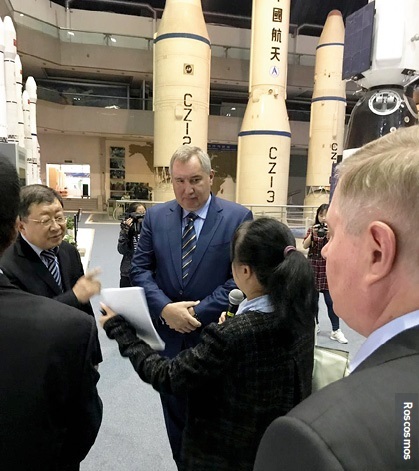 Roscosmos director, Dmitry Rogozin, visiting China.
Roscosmos director, Dmitry Rogozin, visiting China.
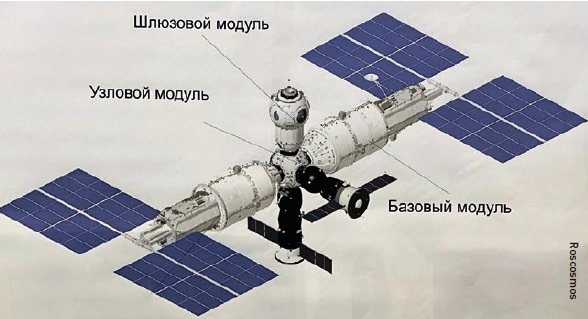 Sketch of Russian Orbital Station (ROS).
Sketch of Russian Orbital Station (ROS).
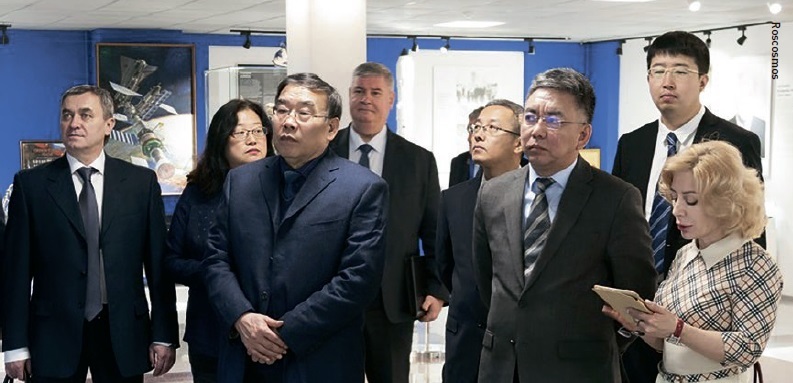 Chinese space officials visiting Moscow.
Chinese space officials visiting Moscow.
Russian Orbital Station
Russia was indeed considering its own space station, but for pragmatic reasons (the ISS ageing) and it was never intended to be a political statement. Russia had long experience of running more than one manned spaceflight at a time (Soyuz 18B and 19 in 1975); and more than one space station at a time (Mir and Salyut 7 in the 1980s; Mir and ISS from 1998-2001), which over-excited headline writers must have overlooked. Russia was, in any case, still preparing two modules for launch to the ISS, the long-awaited Nauka science module and the new Prichal docking port, hardly signs of an imminent or hurried departure.
It was always intended that there would be be an overlapping, transitional process. The Russian Orbital Station (ROS) was first briefed at a meeting in the Energiya design bureau in May 2021. Designers explained that it would be based on what was originally called the power module, once intended for the ISS but still several years away from launch; and that it would fly in polar orbit so as to maximise Earth observations (amateur space watchers in northern latitudes were delighted to hear this). It would start as a small station and provide space experience for the new Orel spacecraft to replace the 1960 design Soyuz, for which a target launch date had been set for 2023.
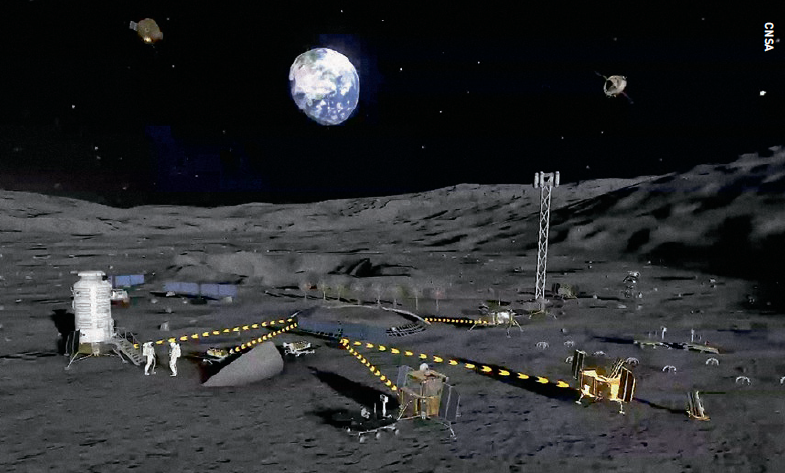 Artist’s rendering of phase 3 of the China-Russia International Lunar Research Station (ILRS) roadmap.
Artist’s rendering of phase 3 of the China-Russia International Lunar Research Station (ILRS) roadmap.
However, this did not preclude Russia and China cooperating on their respective space stations, ROS and Tianhe (to be called Tiangong when complete). The idea of guest fliers to a space station was not new. The Soviet Union had flown guest cosmonauts from 1978, arguably making Salyut 6 the ‘first’ international space station and guest arrangements had continued ever since. In the case of China, Ye Guangfu participated in the European CAVES underground simulation training in the caves of Sardinia in 2016, while Europe’s Samantha Cristoforetti and Mathias Maurer trained in its sea base in Yantai in 2017.
More by accident than design, Russia and China found themselves at a similar point in the development of their unmanned lunar programme
It was expected that this might lead to a European invitation to fly to Tiangong, but the trail ran cold at this point. China’s Dr Wang Yue participated in the European-Russian Mars 500 simulation experiment in Moscow in 2010. From 2021, though, Star Town was empty of both European and American astronauts in training, both now flying on the new SpaceX Dragon to the ISS. This created room for the idea of hangtianyan flying to the ROS later in the 2020s and for cosmonauts to fly on the Shenzhou to Tiangong, an idea mooted but which has yet to progress.
One area that did progress was Russian scientific participation on the Chinese orbital station. Through the auspices of the United Nations in Vienna, China invited countries to propose scientific experiments. Opportunities were extensive because Tianhe and the science modules Wentian and Mengtian had room for 17 tonnes of experimental equipment both inside and outside. Between the ISS and Tiangong, the volume of space available for human-supervised experiments in low Earth orbit doubled at a stroke.
Nine projects were agreed of which one came from Russia (the others were from Belgium, France, Spain, the Netherlands, Poland, Italy, Germany, Norway, India, Japan, Saudi Arabia, Kenya, Peru and Mexico). As if to emphasise the new bi-polar world, the United States applied strong pressure on Italy not to participate, reportedly leading to one of its proposals being taken off the table.
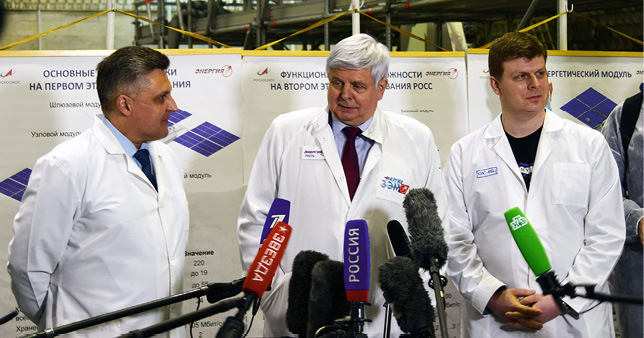 Vladimir Soloviev at Energiya ROS briefing.
Vladimir Soloviev at Energiya ROS briefing.
Working together
It is possible to paint a picture, by the mid- to late-2020s, of Russia and China working together on an increasing range of projects, with cosmonaut/hangtianyuan exchanges on Tiangong and ROS respectively; and both sides developing, separately, the ability to fly cosmonauts and hangtianyuan to the Moon; while jointly developing a single automated, later occupied, lunar base. Russia and China could still be described, at this stage, as flirting with each other, both somewhat nervously. Chinese officials have visited the design bureau of Russian rocket engines, Energomash, but have not yet emerged with Russia’s powerful engines. Russian ion, electron and plasma instruments will fly on China’s Zheng He mission to asteroid Kamooalewa in 2024.
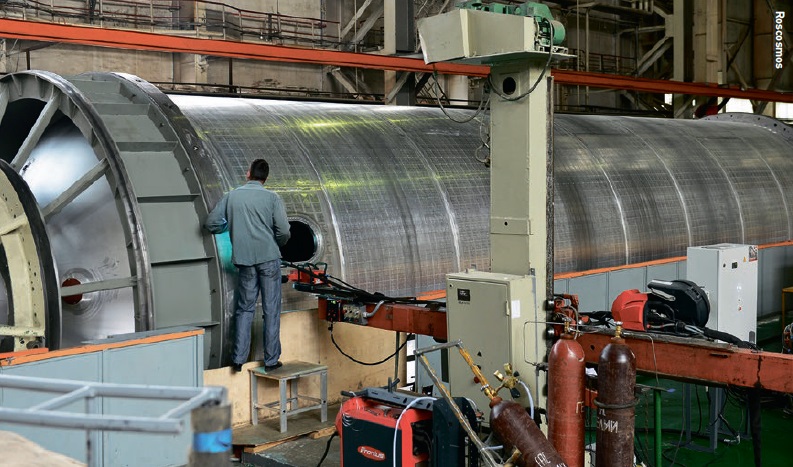 Soyuz 5 rocket and Progress plant, Samara, Russia.
Soyuz 5 rocket and Progress plant, Samara, Russia.
Ultimately, a Russia-China axis on the one hand and a US-led axis on the other will depend on political factors. The bipolar world is largely driven by politics, with sanctions imposed on China from 1949, re-imposed with renewed ferocity from 1999. Sanctions were imposed by the US and Europe on the USSR also from 1949, lifted in 1991, but re-imposed on Russia in 2014 and intensified in December 2020.
It is possible to paint a picture, by the mid- to late-2020s, of Russia and China working together on an increasing range of projects, with cosmonaut/hangtianyuan exchanges on Tiangong and ROS respectively
Sanctioning countries should hardly be surprised if the effect of their sanctions is to drive Russia and China together. They have also had the knock-on effect of reducing cooperation in the middle ground, especially Europe. The current ExoMars project, the biggest single project in European-Russian space science cooperation, was agreed before 2014, but several European space scientists have spoken of how “it would never happen again. The political atmosphere is just too bad”.
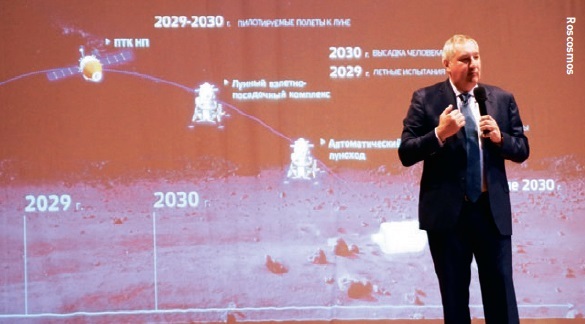 Dmitry Rogozin outlines Russian lunar landing.
Dmitry Rogozin outlines Russian lunar landing.
Indeed, for its successor mission, Mars Sample Return, Europe headed straight to the United States and did not even go through the polite formality of discussions with Russia about a possible project.
Some European instruments are flying on the upcoming Luna missions: Luna 25 (Switzerland); Luna 26 (Slovakia); Luna 28 (Germany); with the largest contribution, a laser landing system, drill, sample handler and analyser on Luna 27 (Britain and Italy). However, this is hardly a programme of cooperation. The days of the Soyuz rocket at the Kourou launch site in French Guiana appear to be numbered, as European customers move to Vega C, Ariane 6 and SpaceX. Similarly, there is project, but not programmatic cooperation, with China: a French experiment on Chang’e 6, for example.
It is difficult, at present, to see a way out of this more confrontational bipolar world of space exploration. However, there may be scientific benefits to there being not one, but two lunar bases: one American and one Chinese/Russian. The peaceful, non-conflicting establishment of bases in Antarctica (such as Mirny, McMurdo, Zhongshan) in the post-war period is an encouraging precedent.
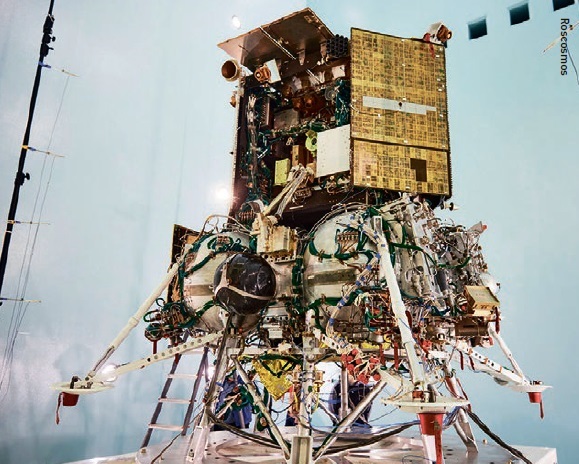 Russia’s Luna 25 under test.
Russia’s Luna 25 under test.
About the author
Brian Harvey is a specialist space writer and broadcaster based in Dublin, Ireland. He is the author of China in Space - the Great Leap (2nd edition) (Praxis/Springer, 2019) and European-Russian Cooperation in Space - from de Gaulle to ExoMars (Praxis/Springer, 2021).





